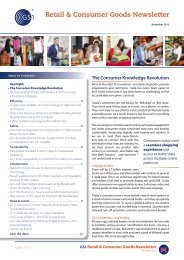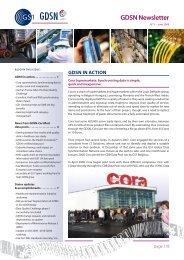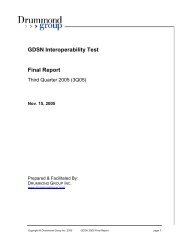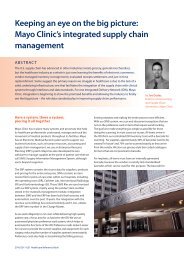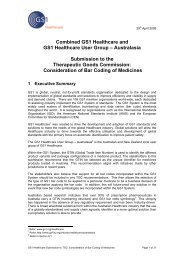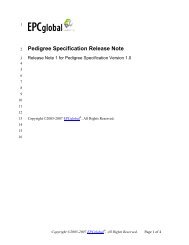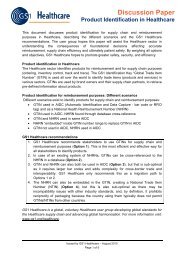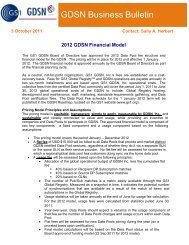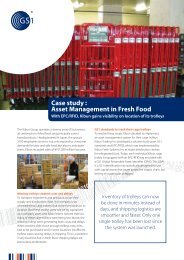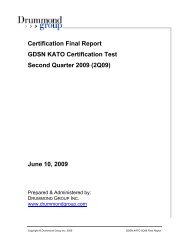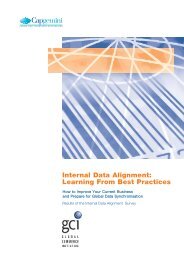The Application Level Events (ALE) Specification, Version 1.0 - GS1
The Application Level Events (ALE) Specification, Version 1.0 - GS1
The Application Level Events (ALE) Specification, Version 1.0 - GS1
Create successful ePaper yourself
Turn your PDF publications into a flip-book with our unique Google optimized e-Paper software.
171<br />
172<br />
173<br />
174<br />
175<br />
176<br />
177<br />
178<br />
179<br />
180<br />
181<br />
182<br />
183<br />
184<br />
185<br />
186<br />
187<br />
188<br />
189<br />
190<br />
191<br />
192<br />
193<br />
194<br />
195<br />
196<br />
197<br />
198<br />
199<br />
200<br />
201<br />
202<br />
203<br />
204<br />
205<br />
206<br />
207<br />
208<br />
209<br />
210<br />
211<br />
location. This allows changes to occur at the physical layer (for example, replacing a<br />
2-port multi-antenna reader at a loading dock door with three “smart antenna”<br />
readers) without affecting client applications. Similarly, it abstracts away the finegrained<br />
details of how data is gathered (e.g., how many individual tag read attempts<br />
were carried out). <strong>The</strong>se features of abstraction are a consequence of the way the data<br />
specification and reporting aspects of the interface are designed.<br />
Unlike the earlier MIT “Savant <strong>Version</strong> 0.1” effort, the present specification does not<br />
specify a particular implementation strategy, or internal interfaces within a specific body<br />
of software. Instead, this specification focuses exclusively on one external interface,<br />
admitting a wide variety of possible implementations so long as they fulfill the contract<br />
of the interface. For example, it is possible to envision an implementation of this<br />
interface as an independent piece of software that speaks to RFID readers using their<br />
network wireline protocols. It is equally possible, however, to envision another<br />
implementation in which the software implementing the interface is part of the reader<br />
device itself.<br />
2 Role Within the EPCglobal Network Architecture<br />
EPC technology, especially when implemented using RFID, generates a very large<br />
number of object reads throughout the supply chain and eventually into consumer usage.<br />
Many of those reads represent non-actionable “noise.” To balance the cost and<br />
performance of this with the need for clear accountability and interoperability of the<br />
various parts, the design of the EPCglobal Network Architecture seeks to:<br />
1. Drive as much filtering and counting of reads as low in the architecture as possible<br />
(i.e., in first preference to readers, then to “middleware”, and as a last resort to<br />
“applications”), while meeting application and cost needs;<br />
2. At the same time, minimize the amount of “business logic” embedded in the Tags,<br />
Readers and middleware, where business logic is either data or processing logic that<br />
is particular to an individual product, product category, industry or business process.<br />
<strong>The</strong> <strong>Application</strong> <strong>Level</strong> <strong>Events</strong> (<strong>ALE</strong>) interface specified herein is intended to facilitate<br />
these objectives by providing a flexible interface to a standard set of accumulation,<br />
filtering, and counting operations that produce “reports” in response to client “requests.”<br />
<strong>The</strong> client will be responsible for interpreting and acting on the meaning of the report<br />
(i.e., the “business logic”). <strong>The</strong> client of the <strong>ALE</strong> interface may be a traditional<br />
“enterprise application,” or it may be new software designed expressly to carry out an<br />
EPC-enabled business process but which operates at a higher level than the “middleware”<br />
that implements the <strong>ALE</strong> interface. Hence, the term “<strong>Application</strong> <strong>Level</strong> <strong>Events</strong>” should<br />
not be misconstrued to mean that the client of the <strong>ALE</strong> interface is necessarily a<br />
traditional “enterprise application.”<br />
<strong>The</strong> <strong>ALE</strong> interface revolves around client requests and the corresponding reports that are<br />
produced. Requests can either be: (1) immediate, in which information is reported on a<br />
one-time basis at the time of the request; or (2) recurring, in which information is<br />
reported repeatedly whenever an event is detected or at a specified time interval. <strong>The</strong><br />
Copyright © 2005, 2004 EPCglobal Inc, All Rights Reserved. Page 7 of 71



